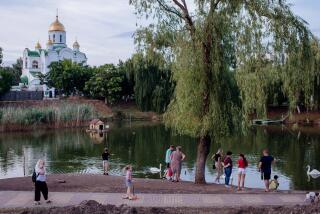RUSSIA’S OUTER LIMITS
- Share via
LAPLANDSKY PRESERVE, Russia — On the slope above the tree line the reindeer stood still, as if etched upon the white, shifting backdrop. Suddenly sensing our presence, they bounded away through the snow and disappeared into the forest.
“Beautiful,” I said.
“Well,” replied Volodya Zolotukin, director of the Biosphere Preserve of Laplandsky, when we reached the summit, “make sure you have a good look around because one of Russia’s last environmental jewels may disappear as quickly as those reindeer.” Laplandsky Preserve, on the Kola Peninsula north of St. Petersburg near Russia’s border with Finland and Norway, is a 1,700-square-mile wilderness and one of Russia’s best-kept secrets. While the former Soviet Union justly earned its reputation as a monstrous environmental despoiler, it did create the largest system of nature preserves in the world. This vast natural collection of forests, lakes and untouched mountain ranges--encompassing all of those in Russia, as well as others in the former Soviet Union--is roughly equal in size to Norway.
Established for scientific research, the 170 zapovedniks (strict nature preserves) in the former Soviet Union range from Arctic islands to Central Asian desert and protect an incredible variety of plant and animal species, including the rare Siberian tiger plus the steppe marmot, the leopard, polar bear, wolf and eagle.
For eight decades--from 1916, when the first zapovednik was created to protect the Barguzin sable--the zapovedniks were off-limits to all visitors except research scientists, and even today some Russians still do not know of their existence. But the collapse of the Soviet Union and the ensuing economic turmoil has left the zapovedniks, which for so long protected animals facing extinction, struggling for survival.
Faced with a host of problems, including illegal logging, poaching, encroaching ranchers and the predatory eyes of Western mining companies, as well as an acute shortage of funds, some of the 95 zapovedniks remaining within Russia’s borders are finally allowing foreign visitors in.
While leisure tourism to the preserves is still prohibited on paper, to raise funds and help win local support, Laplandsky and others have created their own tourism policies. In past years there have been organized tours to Laplandsky--ostensibly for scientific study--and for the last year or so the preserve has received intrepid individual tourists. But regular group access is just opening, and local authorities are looking for ways to promote it.
The trip seemed a compelling opportunity as outlined by Bill Wasch, an American and former work colleague who was traveling there for ecological study. To be among only a handful of Westerners to visit this last, true European wilderness and to make such a trip--one that I understood would be rugged--with a friend fluent in Russian was not a set of circumstances that presents itself often in a lifetime.
I joined him on short notice. He had mentioned that in early spring there would be more than 5 feet of snow in Laplandsky, but the reality hit only as we watched skiers load their equipment through the doors and windows of the train in St. Petersburg. (Being Australian, I have always considered snow an unnatural substance.)
Doubts must have registered on my face as Sasha, a friend of Bill’s, took me aside on the platform of Moskovy train station.
“Don’t worry,” he counseled me, “the only thing you have to watch out for is drunks.” Sure enough, when Bill and I entered our train compartment we found two merry men passing a half-empty bottle of vodka.
*
Tolya, a St. Petersburg businessman, and his friend, Andrei, were on their way to a five-day alpine skiing trip near Laplandsky. Following introductions, Andrei offered us a drink and, as the train set off on its 20-hour journey past endless forests, fences and telephone lines, we passed the bottle to the steady rhythm of the engine.
The train to Murmansk is slow but comfortable. The main lifeline for the remote Kola Peninsula, it stops at each small town, where we saw elderly women standing on the platforms selling hot potatoes and pickled cucumbers.
“It’s better than the dining car,” Tolya said, offering his own snack of tasty homemade pirogi (a dough pocket stuffed with cabbage and meat) to go with the potatoes. “In the dining car the waiters are surly and the food is terrible. The only thing worth buying is the beer.”
Awash with vodka, I slept well. When we stepped off the train in Apatity the next afternoon and said goodbye to our two congenial traveling companions, I understood why Tolya had advised me to watch out for drunks: My hangover was excruciating. We emerged from the train into Apatity, a nondescript Russian town of Soviet block buildings that is in marked contrast to the spectacular Khibiny Mountains to the east. Despite the ugliness, Apatity was a prestige address when compared with the next stop.
In winter, the snow falls black and flakes of freezing ash litter the ground in the muddy mining town of Monchegorsk. That town and Nikel, two of the world’s biggest nickel smelters, are part of the peninsula’s industrial belt.
The country around these towns, once as beautiful as Laplandsky, is now a wasteland, devastated by the sulfur dioxide and heavy metals belched from the smelters for the last 60 years. The sulfur buildup is killing trees and destroying pasture in the eastern part of the zapovednik and displacing the reindeer herds. But of all its problems, poaching is particularly vexing, according to Zolotukin.
“The Kola Peninsula has been in a depression for a long time, and people will do anything for money: Sell the forests, sell the fish, sell the animals. Money is all-important now. No one cares about the future,” Zolotukin said.
Founded in 1932 to protect Europe’s largest remaining reindeer herds, Laplandsky is a perfect example of both the wealth of Russia’s natural heritage and the problems it faces. Lying 87 miles above the Arctic Circle, it is half virgin taiga (a sensitive forest belt between the arctic tundra and the temperate forests of the south) and one-third alpine tundra. The rest is alpine grassland with marshes, rivers and more than 100 glacial lakes.
In winter, when the temperature drops to minus 50 and the northern lights shimmer in the sky, life withdraws from the landscape as the animals retreat deep into the forest. But in the spring and summer, the wilderness abounds with wildlife. Reindeer, moose and elk graze in the lichen clearings, bears hunt through the three mountain ranges, beavers and otters roam the lakes and eagles circle overhead.
By summer, when daytime temperatures can soar to a balmy 75 degrees and the Arctic sun shines continuously for 46 days, this wildlife is joined by rivers full of perch and trout and more than 180 species of birds that nest in the wetlands. Laplandsky is a breeding ground for many migratory birds and is recognized for its international importance.
During the first four decades after the preserve’s founding, the reindeer herds increased greatly, reaching 55,000 in 1969 and straining the preserve’s limited grazing areas. The Soviet government issued an order allowing hunting of reindeer, and by 1985 the population had dipped to approximately 300. The government then reversed that decision, and today there are an estimated 3,000 reindeer on the preserve and reindeer hunting remains forbidden.
*
Travelers who make it to Laplandsky find--as I did--a tranquil, beautiful wilderness of cliffs and forests that, at least for now, is largely untouched. I also found a warmhearted staff that was keen to help.
Chunozerskaya, home to about 20 people, including research scientists, rangers and their families, functions as a base camp for visitors to Laplandsky.
The best time to visit Laplandsky is early spring (March to mid-April) or late summer (mid-July to late August), and there are really only two ways to see the preserve: on foot or, if there is snow, on cross-country skis.
I was surprised at the ease with which I mastered the skis. But not everyone shared the same opinion of my athletic acumen. “Don’t feel bad,” Sergei, a ranger, commented on the first night of our five-day trek. “You’ll pick it up the farther we go along.”
We skied along trails sprinkled with huts, located about every nine miles on the main routes, ensuring adequate accommodation. We stopped at a different hut each night. Although spartan, they were functional, with wood stoves and bunk beds. Some had indoor, non-flush toilets; others had outhouses.
Lake Chunozero, a magnificent 12-mile-long freshwater lake stretching east to west along the southern border of the zapovednik, provides good access to many points within the preserve. It freezes solid in winter, but in spring and summer it is ideal for boating and, for the cost of gas, the staff is happy to take visitors on a tour.
The zapovedniks contain the world’s largest remaining temperate forests, which most scientists believe form an important defense against global warming. On the third evening, however, I was more concerned about the wolves said to roam the woods. Unable to sleep, I dressed and went out. As I walked into the forest, my breath hung thick in the air. In the absolute silence, I looked up in wonder at the cold night sky.
Sometime later, Bill came out.
“Everything OK, Greg?” he asked with concern.
“Almost perfectly so,” I replied, still staring into the sky.
(BEGIN TEXT OF INFOBOX / INFOGRAPHIC)
GUIDEBOOK
Around Laplandsky
Getting there: There is connecting service from LAX to St. Petersburg on Lufthansa and Aeroflot. Advance-purchase, round-trip fares start at $1,430.
Train No. 55 departs St. Petersburg’s Moskovy train station at about 6 p.m. daily for the 20-hour trip to Apatity, the station nearest the Biosphere Preserve of Laplandsky. Round-trip fares are about $85.
Seeing the preserves: Those who do not speak Russian should probably travel with someone who does and/or make arrangements through one of the following organizations:
Steven Levin of Russian Nature Reserve Expeditions at Reymond & Whitcomb Co., 10 Liberty Square, Suite 300, Boston, MA 02109-4802; tel. (800) 232-2939, Ext. 226.
Trips can also be arranged through the American nonprofit organization, American Assn. for the Support of Ecological Initiatives (AASEI), at 150 Coleman Road, Middletown, CT 06457; tel. (860) 346-2967.
AASEI’s Russian representative, Adonis, can help individual tourists. A representative can meet travelers in St. Petersburg, make reservations at a zapovednik and help in purchasing train tickets. (Cost for this service is about $50 per person.) Laplandsky Preserve representatives can meet them in Apatity and provide them with transportation to the preserve. (Cost of this would be roughly $25; food and lodging, extra.) Entry to the preserve is about $5; lodging at Laplandsky huts is $5-$20.) Contact Alexander Karpenko, chairman of Adonis, Komendantsky Prospect 40, k.2, kv.236, 197373 St. Petersburg, Russia; tel./fax 011-7-812-307-0918. English is spoken.
More to Read
Sign up for The Wild
We’ll help you find the best places to hike, bike and run, as well as the perfect silent spots for meditation and yoga.
You may occasionally receive promotional content from the Los Angeles Times.






